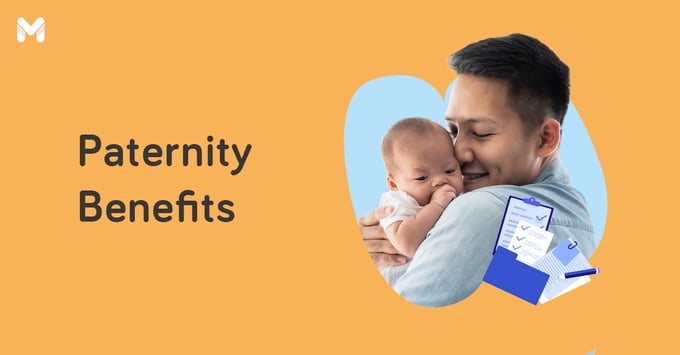Expecting a baby soon? Your role as a father is crucial from the moment you learn about your wife’s pregnancy, more so during and after childbirth. On top of working hard to provide for your new family, you have to give her your time and support every step of the way.
That’s why as a dad-to-be, you deserve to know the paternity benefits in the Philippines. Learn more about paternity benefits, including paternity leave.
What Paternity Benefits in the Philippines Can I Claim?
Let’s set your expectations straight: Paternity benefits differ greatly from PhilHealth and SSS maternity benefits.
For one, these government agencies don’t provide SSS paternity benefits or SSS paternity leaves specifically for expectant fathers. Also, the Philippine Labor Code[1] provides maternity leave benefits only—it doesn’t mention anything about paternity benefits.
However, there are laws that grant paternity leave benefits: the Paternity Leave Act of 1996 or Republic Act 8187[2] and the Allocation of Maternity Leave Credits under Section 6 of Republic Act 11210.[3]
👉 The Paternity Leave Law
-1.png?width=618&height=412&name=Pics%20for%20blog%20-%20600x400%20(34)-1.png)
Under RA 8187, male private and government employees in the Philippines are entitled to seven days of paternity leave with full pay. They should receive their basic salary, allowances, and other monetary benefits for those days.
Paternity leave allows fathers to care for their newborn and wife or to help their partner recover after a miscarriage or abortion.
That’s all you can expect to receive—nothing more, nothing less—except if you’re working for a company that offers a paid paternity leave longer than the government-mandated leave.
👉 Transfer of Maternity Leave Credits
The paternity leave law allows only seven days of paid leave with full pay. But considering that recovering from childbirth requires weeks, even months, that’s really not enough. Your wife needs more assistance during this time.
Fortunately, you can opt to work around your wife’s maternity leave.
The 105-Day Expanded Maternity Leave Law under RA11210 increased the maternity leave period to 105 days with full pay for female workers in private and government sectors. They can extend their leave to an additional 30 days without pay. Solo mothers who are eligible by law are also granted an additional paid 15 days.
So where does paternity leave come in? Under RA 11220 Section 6, your wife can transfer seven days of her leave credits to you, provided she is a private sector employee who avails of the maternity leave transfer.
As mentioned, your wife is entitled to 105 days of leave with full pay. After she transfers seven days of leave credits, that leaves her with only 98 days.
Note that you must be currently employed to avail of this benefit.
How Many Days is Paternity Leave in the Philippines in 2024?
-1.png?width=623&height=415&name=Pics%20for%20blog%20-%20600x400%20(35)-1.png)
The total number of days in paternity leave you can get is 14 days, provided that you avail of the transfer of leave credits from your spouse. The seven days of paid leave is under the provision of the Paternity Leave Law, and the additional seven days is optional under the Expanded Maternity Leave.
In February 2023, House Bill No. 4430, an act proposing extended paternity leave, was filed. Should this become a law, paid paternity leave will be extended from seven days to 30 days, regardless of the father's employment status. The bill also seeks to cover unmarried working fathers living with the mother of their baby.[4]
Need cash to support your growing family? Fund a home improvement, pay off medical expenses, and more with a personal loan. Compare your options below and apply via Moneymax:
|
Provider
|
Loan Amount
|
Monthly Add-on Rate
|
Loan Term
|
Minimum Annual Income
|
Approval Time
|
|---|---|---|---|---|---|
|
UnionBank Personal Loan
|
Up to ₱2 million
|
26.9% per annum
|
12 to 60 months
|
₱250,000
|
As fast as 5 minutes
|
|
UNO Digital Bank Personal Loan
.png?width=149&height=52&name=Unobank-Logo-Colored_Horizontal-Medium%20(for%20MMX).png) |
₱10,000 to ₱500,000
|
1.79% per month (corresponds to annual contractual rates or annual percentage rates ranging from 35.78% to 37.54%)
|
Six to 36 months
|
₱240,000
|
Five to seven banking days
|
|
Metrobank Personal Loan
|
₱20,000 to ₱2 million
|
1.25% to 1.75%
|
36 months
|
₱350,000
|
Seven banking days
|
|
BPI Personal Loan
 |
₱20,000 to ₱3 million
|
Maximum annual contractual rate of 28.67%
|
12 to 36 months
|
Inquire with BPI
|
Five to seven banking days
|
|
Tonik Credit Builder
 |
₱5,000 to ₱20,000
|
4.84%
|
Six to 12 months
|
Inquire with Tonik
|
Two banking days
|
|
HSBC Personal Loan
|
₱30,000 to ₱500,000
|
0.65%
|
Six to 36 months
|
₱168,000
|
Five to seven banking days
|
|
CIMB Personal Loan
|
₱30,000 to ₱1 million
|
As low as 0.83%
|
12 to 60 months
|
₱180,000
|
One to two banking days
|
|
Maybank Personal Loan
|
Up to ₱1 million
|
1.3%
|
Up to 36 months
|
₱300,000
|
Inquire with Maybank
|
|
RCBC Bank Personal Loan
 |
₱50,000 to ₱1 million
|
1.3%
|
Six to 36 months
|
₱360,000
|
5 to 7 banking days
|
|
PSBank Personal Loan
 |
₱20,000 to ₱250,000
|
|
24 or 36 months
|
₱180,000
|
Five to nine banking days
|
Who is Eligible for Paternity Leave?
“Am I entitled to paternity leave if I’m not married to my partner?” “Can I file a paternity leave if I’m not living with my wife?”
Sadly, the answer to both questions is no. The paternity leave is valid only to male private and government employees who are married and living with their partners.
However, under the 105-Day Expanded Maternity Leave Law, the mother can avail of the transfer of leave credits to you even if you’re not legally married.
📌 Paternity Leave Requirements
You can avail of paternity leave benefits if you meet these conditions:
- Employed at the time of childbirth, regardless of employment status (regular, probationary, casual, seasonal, fixed-term)
- Legally married to and living with a wife who’s pregnant, has given birth, or has had a miscarriage
- The pregnancy, childbirth, or miscarriage has not happened more than four times
- Must properly notify your employer within a reasonable time of your wife’s pregnancy and the expected delivery date (not required for cases of miscarriage)
How to Apply for Paternity Leave in the Philippines
Unlike maternity leave benefits, paternity leave isn’t filed with the SSS but with the employer. Here's how to file for paternity leave benefits as soon as you discover that your wife is pregnant:
- Notify your HR department about the pregnancy and the expected due date.
- Fill out a Paternity Notification Form provided by your employer.
- Submit the accomplished form along with a copy of your marriage certificate to HR. Your employer may also require photocopies of your wife’s ultrasound results and other medical records as proof of pregnancy.
- If you’re availing of the additional seven-day leave, prepare the SSS paternity leave requirements: the completed SSS Allocation of Maternity Leave Credits form[5] and the Maternity Notification form.[6]
After you avail of your paternity benefits, submit a copy of your newborn’s birth certificate within a reasonable period. In case of a miscarriage or abortion, submit a medical or death certificate.
Note that each employer may have different policies for filing a paternity leave. It’s best to check with the HR office about the specific steps and requirements.
For your convenience, get a copy of your marriage certificate and your baby’s birth certificate or death certificate through the NSO online service. You won’t have to personally visit an NSO or PSA branch, and you’ll receive your requested documents in your home or office in around three to seven working days.
📅 When Can I File a Paternity Leave?
Would-be fathers can take their paternity leave before, during, and after their wife gives birth. The total number of days off shouldn’t exceed seven working days for each delivery. For example, you can take a two-day leave before your wife’s due date, one day during her delivery, and four days after childbirth.
However, you can take paternity leave only within 60 days after the child's delivery date.
Important Things to Note about Paternity Benefits in the Philippines
- Not all paternity benefits are the same. Make sure to ask your employer about them as early as possible, so you and your spouse can plan ahead.
- If your company already has paternity benefits and they’re more favorable to you as an employee, then they may supersede the government-mandated benefits.
- Even if you’re a new employee in your company, you’re eligible for the paternity leave benefit. As long as you’re currently working and have complete documentation, you can enjoy the paternity benefit.
- The paternity leave for seven calendar days with full pay includes the basic salary and mandatory allowances fixed by the Regional Wage Board according to the DOLE Handbook on Workers Statutory Monetary Benefits.[7]
🎁 Get a Welcome Gift Worth up to ₱7,499 with a UnionBank Personal Loan
Promo period: Until October 31, 2024
Need funds? Avail of a UnionBank Personal Loan via Moneymax—and, if you apply until October 31, 2024, get a welcome gift worth up to ₱7,499!
If your disbursed amount is below ₱250,000, you get Giftaway cash credits worth ₱1,000. If it's ₱250,000 and above, choose between a JBL Flip 6 Portable Waterproof Speaker worth ₱7,499 or Giftaway cash credits worth ₱5,000.
Click the banner to apply now!
This Moneymax UnionBank Personal Loan promo runs until October 31, 2024. Per DTI Fair Trade Permit No. FTEB 199222 Series of 2024. Terms and conditions apply.
Why Should You Take Paternity Leave?
-1.png?width=674&height=449&name=Pics%20for%20blog%20-%20600x400%20(36)-1.png)
Becoming a father is one of the most rewarding things in this world. You don’t want to miss all the firsts with your child! Here are more reasons why taking paternity leave is a must:
✔️ Form a Bond With Your Baby
The first few months after a baby is born are crucial for both mother and child. But it's also an important time for fathers. Paternity leave gives dads the opportunity to form a strong bond with their baby from the beginning.
Studies have shown that fathers who take paternity leave are more likely to be involved in their child's life later on.[8] Paternity leave has positive effects on the mental and physical health of both fathers and children.
✔️ Take Care of Your Partner
New fathers often feel like they’re in uncharted territory after their child is born. You may be feeling overwhelmed and unsure of how to best support your partner.
By taking some time off from work, you can help your partner adjust to motherhood. You can change diapers and soothe the infant when they're fussy.
In addition, you can take on some of the household duties so your partner can rest and recover from childbirth. This can help reduce stress, promote equality in the home, and make the transition to parenthood a little easier for you both.
✔️ Helps Reduce Risk of Postpartum Depression
The first few weeks after a baby is born are vital for bonding and establishing a healthy relationship. Unfortunately, this is also a time when many fathers feel left out and overwhelmed. As a result, some fathers may experience postpartum depression.
By giving fathers the time and space to bond with their babies, paternity leave can help reduce the risk of postpartum depression. In addition, fathers can develop a support network of other parents.
Ultimately, paternity leave can help create a stronger family unit and promote the health and well-being of both parents and children.
It’s also good for businesses. Employees who feel supported by their employers are more likely to be productive and engaged. Offering paternity leave is a win-win for both employers and employees.
Related reading: 9 Benefits You Didn’t Know You Could Get with Your Solo Parent ID
🛍️ Fund Big Purchases, Celebrations, and Milestones with an #UNOnow Loan
Buying gadgets, tools, and equipment for work or business? Gearing up for life milestones such as a wedding or a baby? Looking for ways to fund your child's tuition fees?
If you want both convenience and high loan amounts, check out what UNO Digital Bank has to offer. With an #UNOnow Loan, you can borrow funds starting at ₱10,000 up to ₱500,000 with a monthly interest rate of 2%. You can pay it back in six, 12, 18, 24, or 36 monthly installments.
Apply for an UNONow Loan via Moneymax now!
Paternity Benefits in the Philippines: FAQs
-1.png?width=636&height=424&name=Pics%20for%20blog%20-%20600x400%20(37)-1.png)
1. Is paternity leave only for married couples?
Under the Paternity Leave Law, you must be legally married and cohabitating with your spouse to be eligible for seven days of paternity leave.
However, as mentioned above, your partner can transfer seven days of her maternity leave credits to you whether legally married or not.
2. Are there paternity benefits in SSS?
There are no direct paternity benefits in SSS. But as mentioned, you can transfer maternity leave credits. Make sure you have all the requirements and documentation.
3. Does paternity leave cover miscarriage?
Yes, it does. Whether it’s a live birth, normal delivery, cesarean, or miscarriage, you’re entitled to paternity leave. Just ensure you have all the proper documentation and requirements, then discuss this with your HR team.
4. Is paternity leave convertible to cash?
Unlike other types of paid leaves, unused paternity leave credits can’t be converted to cash. Also, this benefit is non-cumulative—meaning you can’t carry over any unused leave credits to your wife’s next pregnancy.
Use all your seven days of paid leave to make the most of your time off with your wife and newborn.
5. What if an employer refuses to give paternity benefits?
Talk to your HR or write a letter to state your case. You have the right to enjoy paternity leave, as long as you meet all the conditions under the law.
If your employer still denies your paternity benefits claim, file a complaint with the Department of Labor and Employment (DOLE) through its 24/7 call center hotline: 1349.
According to the Paternity Leave Act, companies that violate the law should pay a fine of not more than ₱25,000 or be jailed for at least 30 days up to six months.[9]
Related: What to Do if Your Employer Fails to Pay Your SSS Contributions
Final Thoughts
No matter how insignificant they seem, paternity benefits can help you fulfill your role better as a new father.
As more and more fathers take advantage of their right to paternity leave, hopefully, more employers will start offering paternity benefits in the Philippines voluntarily. After all, taking time off is important not only for you but also for the mother and the baby.

Sources:
- [1] Labor Code of the Philippines
- [2], [9] Republic Act 8187: Paternity Leave Act of 1996
- [3] Republic Act No. 11210
- [4] House bill seeks paternity leave extension (Inquirer, 2023)
- [5] SSS Allocation of Maternity Leave Credits Form
- [6] Maternity Notification
- [7] 2023 Handbook on Workers Statutory Monetary Benefits by DOLE-BWC
- [8] A fresh look at paternity leave: Why the benefits extend beyond the personal (McKinsey, 2021)







%201200x350%20CTA-1.png?width=751&height=219&name=UB%20PL%20Generic%20Ad%20(Sep%202023)%201200x350%20CTA-1.png)
-Aug-08-2024-06-19-14-9814-AM.png?width=734&height=214&name=image%20(3)-Aug-08-2024-06-19-14-9814-AM.png)
_1200x350.png?width=734&height=214&name=UNOBank_Loan_Generic_Ad_(Apr_2024)_1200x350.png)


